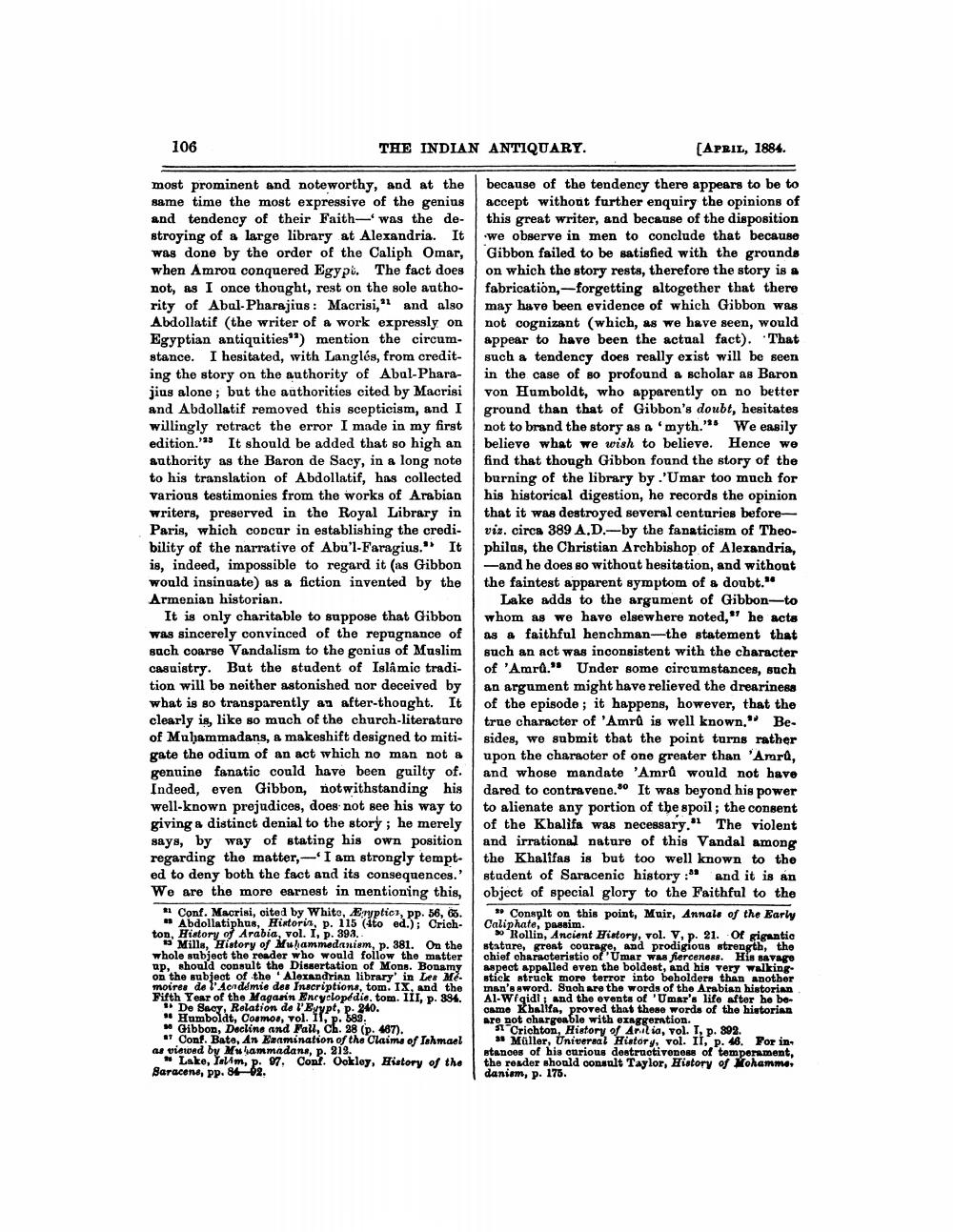________________
106
THE INDIAN ANTIQUARY.
[APRIL, 1884.
most prominent and noteworthy, and at the same time the most expressive of the genius and tendency of their Faith—was the destroying of a large library at Alexandria. It was done by the order of the Caliph Omar, when Amrou conquered Egypt. The fact does not, as I once thought, rest on the sole authority of Abul-Pharajius: Macrisi," and also Abdollatif (the writer of a work expressly on Egyptian antiquities") mention the circumstance. I hesitated, with Langlés, from crediting the story on the authority of Abal-Pharajius alone; but the authorities cited by Macrisi and Abdollatif removed this scepticism, and I willingly rotract the error I made in my first edition." It should be added that so high an authority as the Baron de Sacy, in a long note to his translation of Abdollatif, has collected various testimonies from the works of Arabian writers, preserved in the Royal Library in Paris, which concur in establishing the credibility of the narrative of Abu'l-Faragius." It is, indeed, impossible to regard it (as Gibbon would insingate) as a fiction invented by the Armenian historian.
It is only charitable to suppose that Gibbon was sincerely convinced of the repugnance of such coarse Vandalism to the genius of Muslim casuistry. But the student of Islamic tradition will be neither astonished nor deceived by what is so transparently an after-thought. It clearly is, like so much of the church-literature of Muhammadans, a makeshift designed to mitigate the odium of an act which no man not a genuine fanatic could have been guilty of. Indeed, even Gibbon, notwithstanding his well-known prejudices, does not see his way to giving a distinct denial to the story; he merely says, by way of stating his own position regarding the matter,-'I am strongly tempted to deny both the fact and its consequences.' We are the more earnest in mentioning this,
* Conf. Macrini, oited by Whito, Eryptios, pp. 56, 60.
# Abdollatiphus, Historin, p. 115 (4to ed.); Crichton, History of Arabia, vol. I, p. 393.
15 Mills. History of Muhammedanism, p. 381. On the whole subject the reader who would follow the matter ap, should consult the Dissertation of Mons. Bonamy on the subject of the Alexandrian library' in Les M. moires de l'Académie des Inscriptions, tom. IX, and the Fifth Year of the Magarin Encyclopédie. tom. III, p. 894.
# De Sacy, Relation de l'Eyypt, p. 240. " Homboldt, Cosmos, vol. 11, p. 582.
Gibbon, Decline and Faul, Ch. 38 (p. 487). * Conf. Bate, An Examination of the Claims of Ishmael as viewed by Muhammadana, p. 219. Saracene, pp. 8462.
because of the tendency there appears to be to accept without further enquiry the opinions of this great writer, and because of the disposition we observe in men to conclude that because Gibbon failed to be satisfied with the grounds on which the story rests, therefore the story is a fabrication,- forgetting altogether that there may have been evidence of which Gibbon was not cognizant (which, as we have seen, would appear to have been the actual fact). That such a tendency does really exist will be seen in the case of so profound a scholar as Baron von Humboldt, who apparently on no better ground than that of Gibbon's doubt, hesitates not to brand the story as a 'myth." We easily believe what we wish to believe. Hence we find that though Gibbon found the story of the burning of the library by 'Umar too much for his historical digestion, he records the opinion that it was destroyed several centuries before viz. circa 389 A.D.-by the fanaticism of Theophilas, the Christian Archbishop of Alexandria,
-and he does so without hesitation, and without the faintest apparent symptom of a doubt."
Lake adds to the argument of Gibbon-to whom as we have elsewhere noted," he acts as a faithful henchman-the statement that such an act was inconsistent with the character of 'Amra." Under some circumstances, such an argument might have relieved the dreariness of the episode ; it happens, however, that the true character of 'Amrü is well known," Be. sides, we submit that the point turns rather upon the character of one greater than 'Amra, and whose mandate 'Amr would not have dared to contravene. It was beyond his power to alienate any portion of the spoil; the consent of the Khalifa was necessary." The violent and irrational nature of this Vandal among the Khalifas is but too well known to the student of Saracenic history and it is an object of special glory to the Faithful to the
Consylt on this point, Muir, Annals of the Early Caliphate, passim.
» Rollin, Ancient History, vol. V, p. 21. Of gigantic stature, great courage, and prodigious strength, the chief characteristio of 'Umar was fierceness. His savage aspect appalled even the boldest, and his very walking stick struck more terror into beholders than another man's sword. Such are the words of the Arabian historian Al-Wfqidi; and the events of 'Umar's life after he begame Kballta, proved that these words of the historias are not chargeable with exaggeration.
Crichton, History of Anilia, vol. I, p. 892. * Müller, Universal History, vol. II, p. 46. For in. stances of his curious destructiveness of temperament, the reader should consult Taylor, History of Mohammo danism, p. 175.
Lake, Ielim. B.




